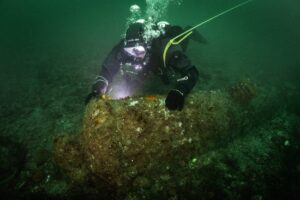Fourth dive of the day done, the liveaboard is at anchor and we’re all tucking into dinner and Lightroom! Surely the photographic action is over for the day? The marine life of the Maldives has other ideas. For several years now, it has been common for liveaboards in the Maldives to fit large lights to their rear decks, which once at anchor attract plankton. It is a bit like doing a blackwater dive, without having to get in! However, the aggregated plankton are just the starter, as the main course is further up the food chain…
At the right anchorages these visitors can be marine megastars! On my recent liveaboard week in Ari Atoll we has multiple mantas, a pair of whale sharks, bottlenose dolphins and tawny nurse sharks all swimming up to the lights of our liveaboard after dark.
It is nature and there are no guarantees. There is a lot of luck in what turns up, and since there might be several liveaboards in an area, you can be unlucky while the boat a few hundred metres away are having their mind’s blown!
Both mantas and whale sharks feed directly on the plankton, and any factor that aggregates plankton is great news for them. Filter feeding is hard work because when you open that mouth it takes a lot of energy to push yourself through the water to filter out the food. Imaging trying to push a huge trash bin ahead of you when you dive, it takes a lot of effort. That energy expenditure isn’t worth it, unless they are getting more energy back in return from the food. So when the plankton are aggregated, the mantas and whale sharks can get more food for less effort, and both species have learned to make the most of this opportunity.
The mantas put on the most impressive display during our week. They arrived at dusk, stayed until we went to bed and there was still one there looping through the ball of plankton when we got up the next day. We were even able to dive with them, setting up a line of torches on the seabed for the mantas to swim down and guzzle the plankton massing around each one. Having been on many night dives with plankton buzzing annoyingly around my torch, I did take some pleasure in seeing the behaviour bring some consequences for the worms and shrimps! But of course the big thrill was watching the graceful mantas swoop and scoop right in front of our masks! The adjustable beam angle of my EOS 5 torch was great for this – setting it at its widest beam created a really concentrated ball of plankton in front of my camera, although next time I do this trip, I am going to take its big brother the EOS 32 – as more light means more plankton and hopefully even more manta action! After the dive the mantas returned to feeding at the back of the boat and we were able to get different images of them while we snorkelled with them and with a few nurse sharks that turned up.
The next night a different anchorage provided the chance for whale sharks. We weren’t as lucky with these, although we did get brief visits from two individuals around midnight. The first didn’t stay long enough for us to get in with it, frustratingly leaving just as we were all kitted up and ready to go. The second turned up around 20 minutes later, and several of us decided to photograph it from the back of the boat while others tried getting in. There were lots of bottlenose dolphins around that night and they were echo-locating loudly which might have put the sharks more on edge. The dolphins were hunting fish that were attracted in to feast on the plankton, but they tended to stay away from the light, so weren’t so good for photos either. I don’t think I’ve ever been disappointed to see dolphins before, but then exploring the underwater world is always full of new experiences!
The post Visitors In The Night appeared first on Mares – Scuba Diving Blog.
Read MoreDiving, diving, dolphins, maldives, manta, Mares, night, ocean, photography, underwater, whale sharkMares – Scuba Diving Blog

